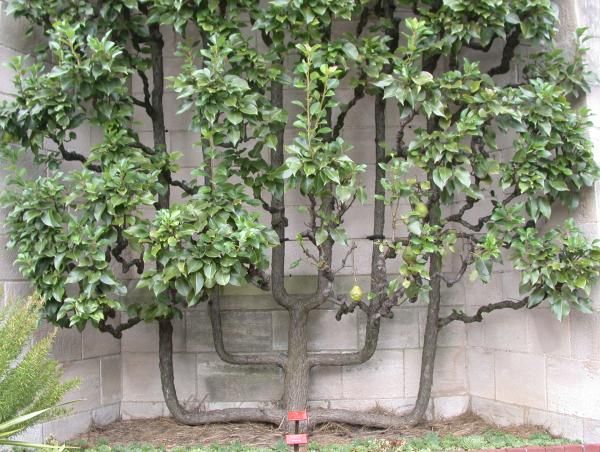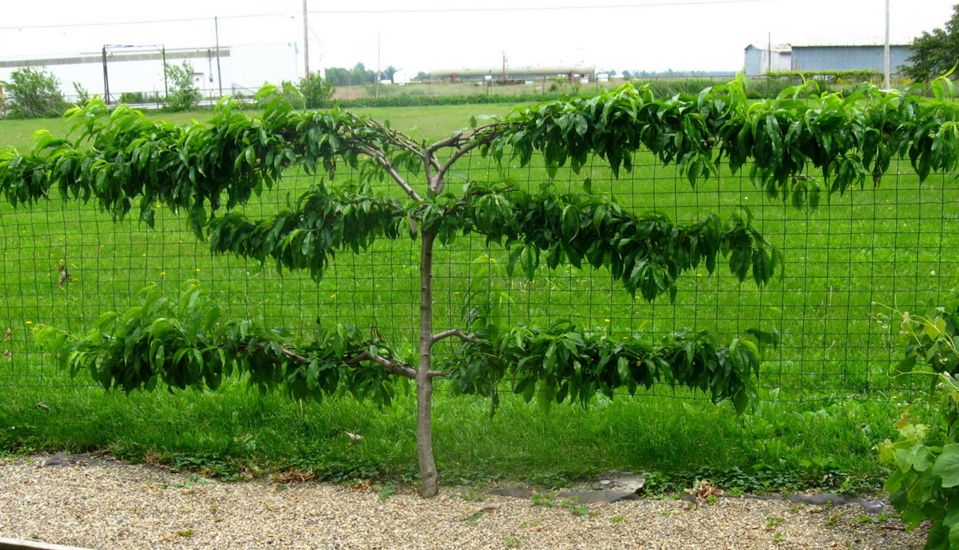What are Espaliered Fruit Trees?

Depictions of espalier fig trees have been found on the walls of Egyptian tombs and throughout the art of the middle ages. But in the 21st century, espalier fruit trees are popping up more and more in the back yards of Americans.
The art of espalier is when trees and branches are pruned and trained to be on one plane. They're commonly found up against a wall or fence. Not only is the look a classic focal point in your landscape, but it helps to maximize your growing space. Espaliering can help keep your fruit trees in check while still providing you with a bountiful harvest. Implementing an espalier tree still requires maintenance throughout your growing season, but no more than any other backyard fruit tree.
Beginning Your Espalier
To begin the process, plant your tree 6-10 inches from a wall or fence. If your tree is bordering a walkway, you will need to build or purchase a frame trellis and train your tree's young branches to it.
Pruning and training
There will be 2 major times you'll be pruning your espalier fruit trees:
- In the winter (when your tree is dormant), you should be performing your major cuts and pruning your fruit tree back. This will stimulate growth and bud production in the spring.
- You will also prune in late spring/summer for the purpose of creating your tree "shape"; as it grows, you will train the branches to follow the pattern you want.
Keep in mind these basic pruning principles
- always cut back to a bud, a lateral branch, or to the main trunk
- avoid leaving long stubs when you make your cuts
It will take up to 4 years of training and pruning to have a great-looking tree and a bountiful fruit harvest.
Espalier Patterns
Once you pick the location and the type of edible plant to use in your garden, it's time to pick what style of espaliering. There are many styles to try. I hope to have as many different styles in my garden as I can. The most popular patterns are the following:
Horizontal
One main trunk is grown in a horizontal direction or multiple tiers of branches are trained horizontally along the wall, fence, or support. This is great to use with grapevines along a short fence — or a fruit tree against a wall. The lattice pattern is best accomplished by planting multiple trees close together, depending on the amount of space you have and the size of the lattice you want. Then branches are trained to intertwine in a lattice pattern. This is a perfect pattern to try with fruit trees as a border along a walkway, or as a hedge along a short fence.
Fan/Candelabra
One main trunk with branches trained symmetrically to grow at a 45 degree angle. This style is perfect to use with a pear tree up against a wall.
So, as long as the ground hasn't frozen where you are, order your trees from Stark Bro's and get them in the ground so you can have fresh fruit and a great-looking garden.
Learn How to Espalier Fruit Trees
Types of Edible Plants to Espalier
The following edibles are great choices for espalier, all available at Stark Bro's:
Apple Trees
Cherry Trees
Peach Trees
Plum Trees
Persimmon Trees
Grape Vines
Guest author, Patti Moreno, the Garden Girl




